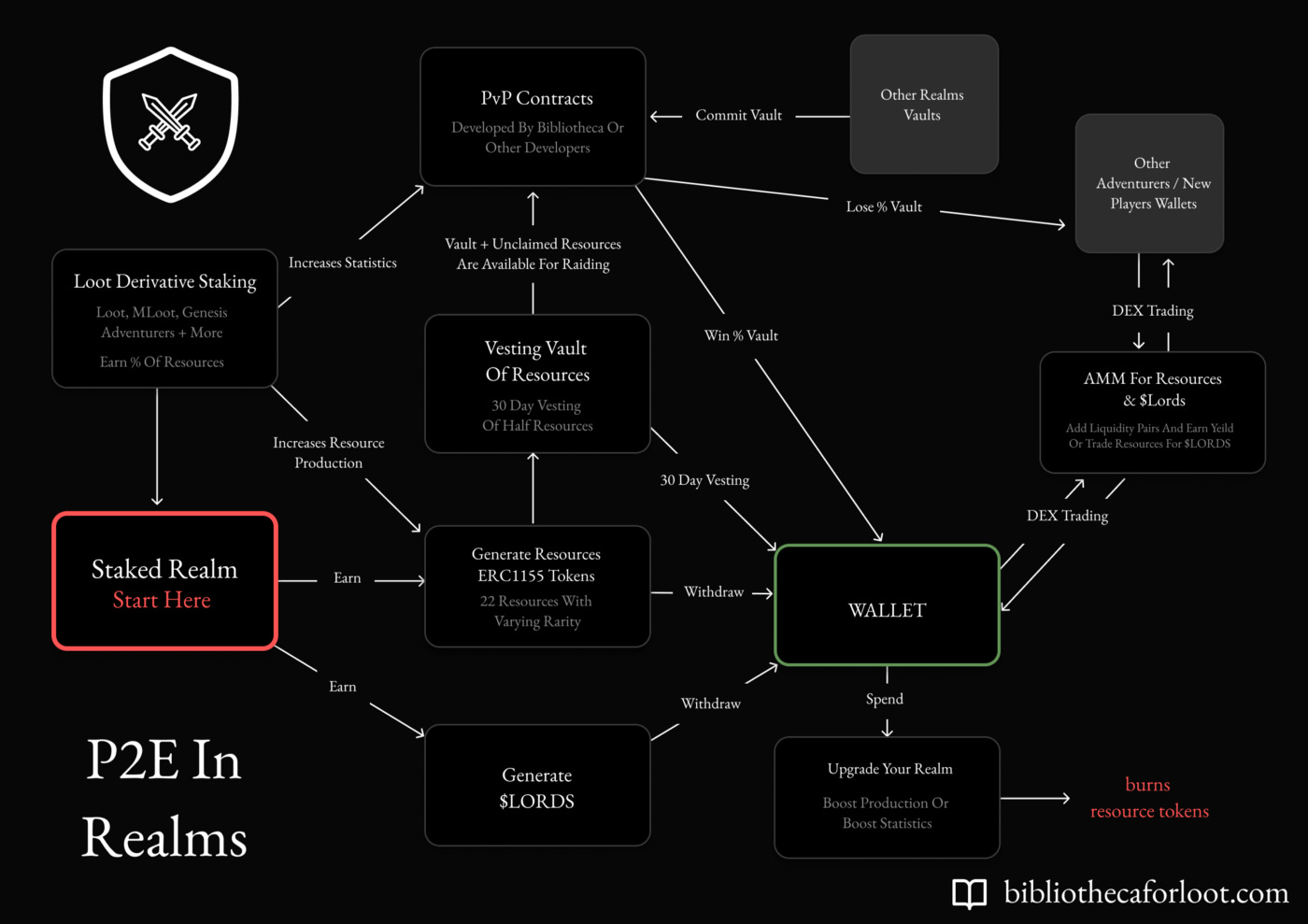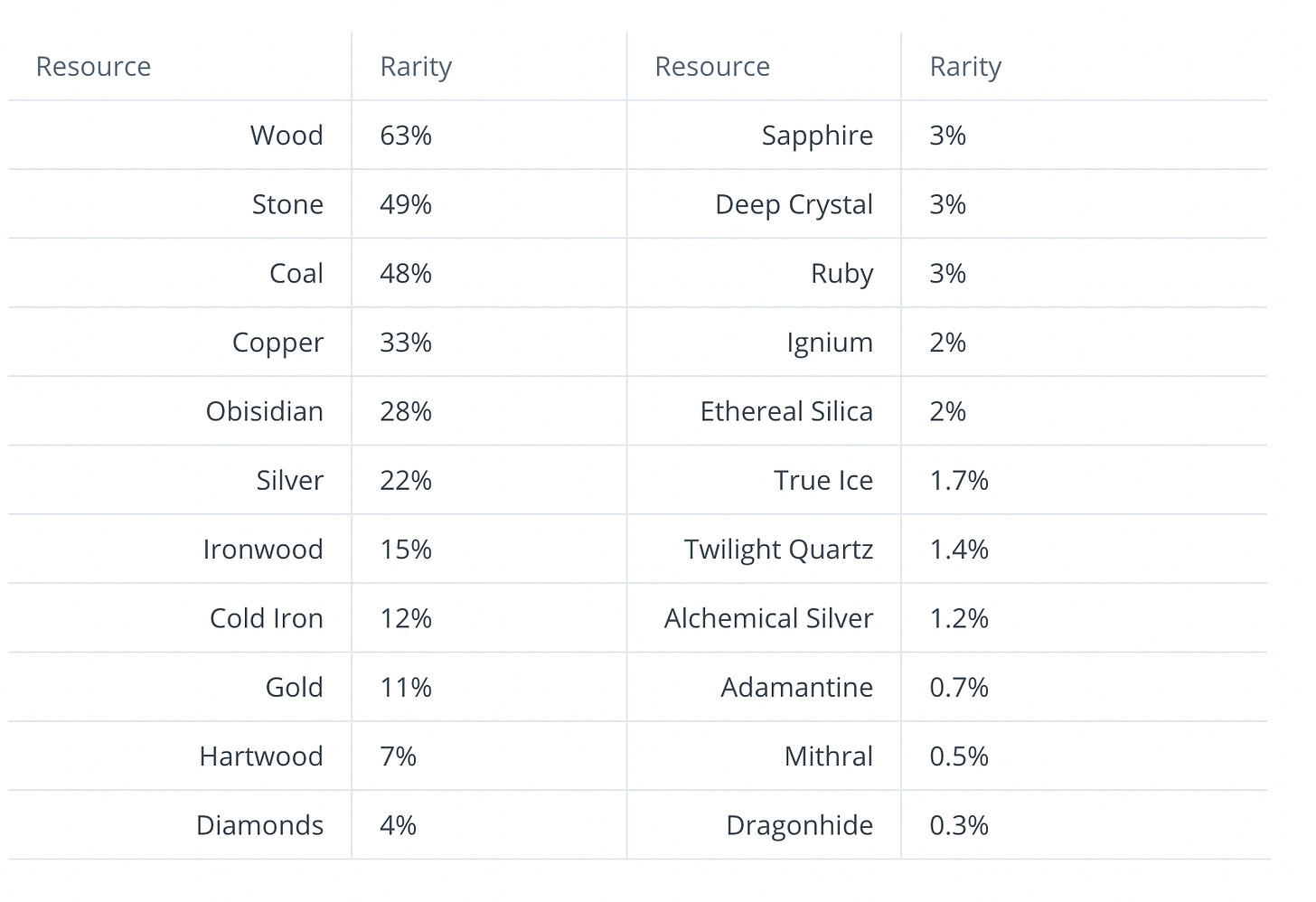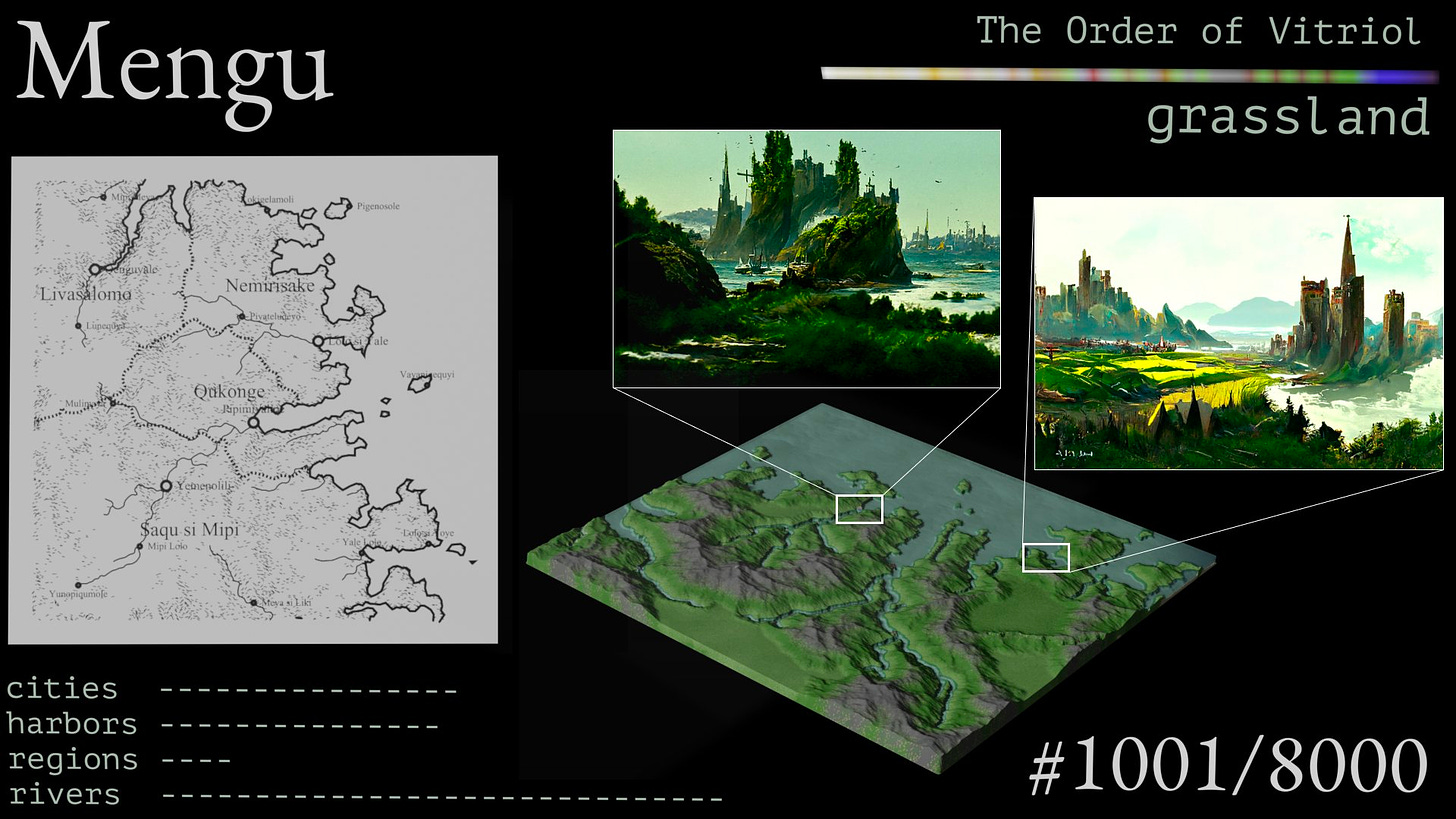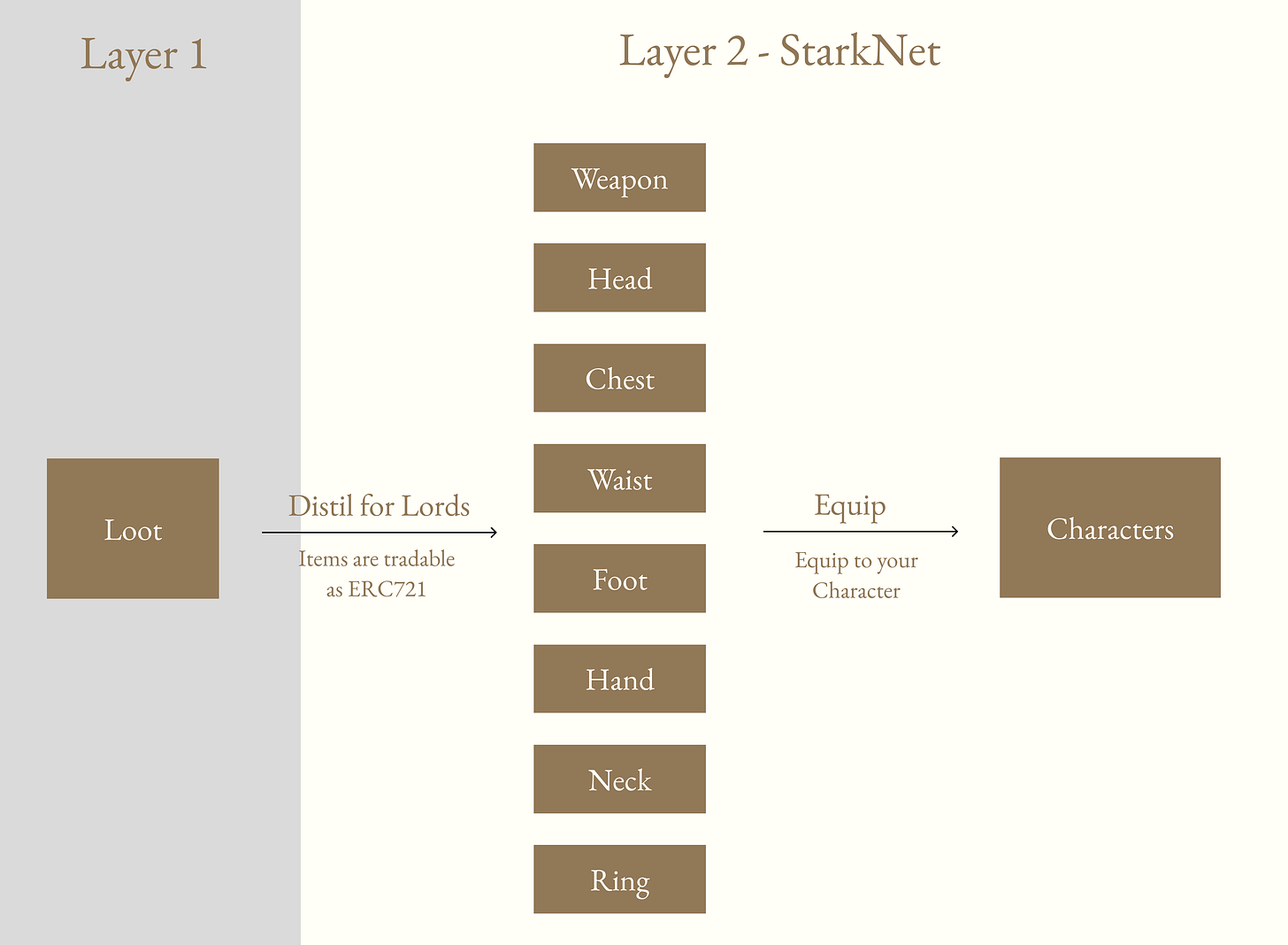Realms, a Loot derivative chain game that combines playability and economic benefits
Original Title: "Realmverse is Here! The Loot Potential That Disrupts Game Concepts Will Be Unlocked"
Author: D1 Intern
As a derivative project of the Loot ecosystem, D1 Ventures believes that with the strong game development and problem-solving capabilities of its team, the community potential after widely incorporating third-party independent developers, a well-designed in-game circular economy system, and mechanisms to lower entry barriers for expanding ordinary players, Realms has the potential to become a next big game on chain.
On the other hand, based on the current market value of the released NFT assets and the released token LORDS, D1 Ventures believes that the project is undervalued. With the recent delivery of key milestones approaching, Realm has the potential to leap into the most influential Loot metaverse game project (if not the only one). After all, for Loot holders, after experiencing Loot's disruption of people's imagination about NFTs and minting several useless zero-value Loot derivatives, they have finally welcomed the first playable and economically rewarding on-chain game.
Introduction to Realms
The Realms team started from a hackathon, initially aiming to present a data visualization dashboard related to the Loot ecosystem (Loot and its derivative assets). Later, the Bibliotheca team joined, and its vision transformed into "helping to continuously expand an interactive metagame-based hyperverse on layer two."
As a derivative of Loot bags, the initial assets issued by Realms are 8,000 Realm NFT plots, which are a series of kingdom city-states, each Realm NFT having its unique geographical location: they may be cities or regions, adjacent to rivers or near ports; each Realm produces different mineral resources, with a total of 22 different Resources combinations, each with varying quantities (scarcity); additionally, 50 Realm NFTs possess 50 mythical wonders (Realms with Wonders will tax other Realms), such as the Pantheon of Chaos, the Azure Relic Chest, and the Altar of Divine Will.

Game Screenshot
The 8,000 Realms are the main locations where future Loot metaverse (Lootverse) games will take place and are the primary productive assets continuously injecting liquidity into this expanding Lootverse. The game objective for Realms lords (Realm NFT holders, also known as Lords & Ladies) is to build their territories, form alliances, and harvest Resources. Meanwhile, as lords of Realms, they also need to build their armies to defend their territories, prevent raids, and protect resources from being stolen by other nations.
Realms Game Asset Cycle
For any game to operate sustainably and stably, it must have a well-designed economic system. By analyzing the four key links of production, accumulation, trading, and consumption in the game system, one can determine whether there is a demand for trading game items, whether the asset supply speed and asset consumption demand reach a dynamic balance, and whether it can guide the entire system to expand to a larger scale, attracting more participants or players.
We see such potential in Realms.
There are two main assets in Realms: LORDS and Resources. The former is the native token, which, besides governance functions, mainly serves as a medium for trading various in-game assets, items, and equipment. The latter is a general term for various functional/useful resource tokens in the game, with a total of 22 different resources initially issued. These Resources participate in different gameplay scenarios based on their unique use cases, and players need to allocate existing resources to maximize productivity output through resource exchanges and trading in the market.
Once the "Settled" phase of Realms is completed (scheduled to launch on the StarkNet mainnet in Q2 2022), Realms NFTs will begin to produce various mineral resources at a rate of 100 per day across their national territories. For example, a Realm NFT with multiple resource attributes (as shown below) can mine 100 units of coal, 100 units of ironwood, 100 units of rubies, 100 units of stone, and 100 units of wood daily. If your Realm NFT only has one type of wood, it can only mine 100 units of wood daily.

The LORDS token is also released through Realm NFT staking (in the The Journey phase in Realms) and later in-game mechanisms. Among them, Realm NFT staking will release 10% of the total supply and is the main source of early circulating tokens. In the first 10 epochs, each Realm releases 625x $LORDS weekly, gradually decreasing over time. Currently, it is in Epoch 14, releasing 350x $LORDS weekly. The release ratio for later in-game mechanisms is 57.5%, to be completed within 2-5 years, with specific details adjusted based on future game supply and demand conditions. Other portions include Bibliotheca Treasury (22.5%), LP incentives (5%), and developer funds (5%) for release.

LORDS Market Cap: 15.49 million, FDV is 152 million USD, with a maximum supply of 500 million tokens. The current circulating supply mainly comes from staking releases and liquidity mining, accounting for about 10% of the supply, with a low 24-hour trading volume of only 208,000 USD.
Considering that the project is still in its early stages and the token currently has no use cases, it is expected that with the recent delivery of several important functions and products, the LORDS token will experience a certain degree of increase.
Resource Production and Consumption
As the most important production and consumption resource, Resources occupy a core position in the Lootverse game economy. Resources are an ERC 1155 token, and whether building a nation or enhancing productivity (mining speed), various Resources must be consumed.
Each type of Resource has an initial mining speed of 100 units released daily, which is also the supply method for Resources. If one wants to enhance the mining speed, they need to upgrade it, which requires consuming a specific number/type of Resources for different resource mining upgrades. Higher-level upgrades require additional steps to complete, such as winning rare loot NFTs from specific adventures, providing opportunities for ordinary players to participate.
If upgrading mining tools to improve productivity is relatively simple, then building and governing a nation is a more daunting task. It not only requires consuming a large amount of Resources (which means expenditure costs), but it also requires lords to balance expenditures on various infrastructure constructions, directly affecting productivity levels within their territories (Realms).
In the Realm strategy game, each lord (Realm holder) alters the population structure, productivity levels, military capabilities, and happiness of their nation by constructing various infrastructures within their territories, thus influencing the numerical levels of these attributes.

For lords, each new building constructed within their territory will impact the data across these dimensions:
For example, building a Royal Reserve will add 5 units of food and 5 units of military while consuming 10 units of population; military construction can enhance military defense capabilities, benefiting competitiveness, protecting national resources, and even plundering resources from other nations, but the military requires a large amount of food, approximately 100 times the population;
Building 1 unit of housing will add 100 units of population, which can enhance the nation's productivity level, but 100 units of population will consume 1 unit of food. Additionally, the population needs food and cultural supplies; once these supplies are lacking, the nation's happiness will decrease, thereby reducing productivity;
It is important to note that the population number represents the labor force situation of the nation. Whether creating armies or building urban infrastructure, the population is essential, directly impacting productivity. Meanwhile, food and culture are necessities for the population; every 100 people require 1 unit of food and 1 unit of culture for sustenance. If food and culture are lacking, happiness will decline, and productivity will also be affected.
Happiness is crucial for enhancing a nation's productivity. The happiness value is influenced by food and culture. Whether for the military or the population, food supply is necessary; if food is lacking, happiness declines. For the population, every 100 people lacking food or culture will decrease happiness by 1%. Conversely, a nation rich in culture or food will see an increase in happiness, which can drop from an average of 100 to 50, or rise to a maximum of 150. This means that lords cannot blindly expand the population; they must also provide sufficient food and cultural facilities (such as building parks and theaters) to achieve balanced development and enhance overall productivity.

Game Visual Sneak Peek, Source SECRETIVE
The military is an essential infrastructure for a nation, used for raids, defense, and expeditions. After the Realm "Settling phase" begins, staking Realms will start producing resources at a rate of 100 units daily, with weekly withdrawals, but each time only 75% can be extracted, while the remaining 25% will be stored in the Vault. This portion of resources is also a key point for nations to engage in military wars for wealth. Lords can enhance their military capabilities by creating more military buildings; the stronger the capability, the greater the plundering ability, thus allowing them to acquire more wealth by plundering other nations' Resources. On the other hand, even if you do not wish to participate in plundering wars, you must still nurture your nation's military to prevent this 25% of resources from falling into the hands of other nations. However, while developing the military can enhance combat power and accelerate wealth accumulation, the military requires food consumption 100 times that of the population, and an excess of military forces will crowd out labor space, thereby affecting the ability to enhance resource mining.
As an important asset in the game, almost all activities/play styles in Realms revolve around Resources. Whether building a nation, conducting military defense construction, or enhancing productivity, a large amount of various resources must be consumed, and a nation's resources are limited. Therefore, for lords, it is essential to balance expenditures on construction, productivity, and military defense to maximize their position in economic competition.

Asset Cycle within the Realms Ecosystem
Here are some strategies provided by the official team for reference:
Use available resources for resource mining upgrades and defense measures, maintaining military defense and productivity construction within the territory;
Maintain happiness levels within the territory to maximize the productivity output of currently available assets;
Sacrifice the happiness of the population (and resource production) to build buildings, increasing military limits to plunder resources from other nations;
Maintain the labor population and provide sufficient food, housing, and cultural supplies to increase the labor force available for production.
Native Token LORDS
There are a total of 22 different rare resources in Realms, with each Realm distributing different resources based on their attributes, ranging from common stones, coal, and wood to rare gems, mithril, and dragon skins.

For lords, whether upgrading mining tools to enhance productivity or building a nation, various quantities of different resources are required. Generally, each Realm produces only one to two types of unique mineral resources, creating a significant demand for resource trading.
To meet the trading needs of players within the game, the development team has created an AMM DEX using StarkNet layer two technology. Its sufficiently low transaction costs not only solve the frequent trading scenarios of in-game assets but also provide ordinary players with the possibility of instant exit. As the native governance token in the game, LORDS also serves as a trading medium for in-game resources, allowing any player to sell the resources they obtain in the DEX in exchange for LORDS tokens, gaining instant liquidity. According to the official statement, a liquidity reward program for LPs will be launched in the future, providing liquidity distribution token rewards for resource trading pairs such as Wood & $LORDS, Mithral & $LORDS.
Additionally, other use cases for LORDS include: trading medium for the NFT Marketplace, minting Lords and Ladies PFPs, extracting Loot bags, and proof of holding threshold for entering the game (players need to hold a certain amount of LORDS tokens to enter the game).
Key Advantages of Realms
As a derivative project of the Loot ecosystem, D1 Ventures believes that with the strong game development and problem-solving capabilities of its team, the community potential after widely incorporating third-party independent developers, a well-designed in-game circular economy system, and mechanisms to lower entry barriers for expanding ordinary players, Realms has the potential to become a next big game on chain.
Core Development Team
The core developers of Realms started from a hackathon, and later the Bibliotheca team joined. Currently, the core development members have expanded to include several active developers in various communities, such as lordOfAFew, RedBeard, LevelsOfDescription, and MikeN.
As one of the most influential developer communities in the Loot ecosystem, the project has naturally gained support from Loot issuer dom and The Genesis Project (for Loot) developer TimshelXYZ. Dom and Tim Shel have consistently supported the construction of the Loot ecosystem, having retweeted related content multiple times. Tim Shel's own project, The Genesis Project (for Loot), will also be integrated into the Realms ecosystem.
Realms initially adopted the Arbitrum layer two scaling solution (previously deployed Alpha on Arbitrum), but after some practice, it was found that while it could reduce game transaction costs, it was not the best solution for high-frequency trading scenarios of in-game assets. StarkNet, on the other hand, can lower transaction costs even further and does not have the lengthy withdrawal process of up to 7 days. In February of this year, the Realms development team also received support from the StarkNet team, not only obtaining a 5ETH grant from StarkWare for developing the ERC1155 AMM but also having StarkWare ecosystem head Louis Guthmann participate in discussions about the possibilities of developing Lootverse games on StarkNet.
Community and Scalable Developer Community
The Realms Discord currently has a total of 6,600 members, with a significant portion being game enthusiasts and independent game developers, in addition to some asset holders. Discussions in various channels are very active, and many of the released gameplay ideas have originated from discussions within the group.
Realms is an open on-chain metaverse game. For third-party developers, if they have good ideas and gameplay, they can directly issue them in Realms in the form of NFTs and receive appropriate rewards. This is also a core advantage of Web3 games, allowing for the direct monetization of assets to expand gameplay, providing developers with a strong economic incentive to create new game models and player creations, which in turn will generate more demand for the game's ecosystem tokens. This serves as a natural driving force for the innovator's dilemma, creating continuously evolving games with longer half-lives.
New assets are equivalent to DLC expansion packs, enriching the game's playability. For example, developers can issue assets for player exploration and upgrades, which players can equip to their characters after purchase. The concept of creation rights is an important feature of the open metaverse, signifying infinite possibilities. Players in metaverse games can break free from the gameplay designed by game designers, exploring their own survival methods. Just like in the real world, players can create their own items, with the financial system supporting free trading, and the physics engine allowing players to reach different locations or even redefine maps through their creations. It can be said that, aside from the core team, the playability and future potential of the Realms game depend on the imagination of the third-party developer community.
An existing case is Crypts & Caverns, which was initially issued as a Loot derivative map. After a poor initial sale, it sold out shortly after being integrated into the Realms ecosystem, with its floor price rising significantly. Crypts & Caverns NFTs mainly provide the game with: unique coordinates waiting for players to explore and navigate; the ability to view Realms locations and neighbors; exploration of the distribution of caves and caverns on land and sea; and the ability to browse high-fidelity Realms, with the generation of these height maps being CC0 and available for free download.

Although the initial release of Realms consisted of 8,000 low-fidelity territory maps (left image in black and white), the future possibilities depend on the imagination of the developer community and players (bottom right is a high-fidelity map released by the Crypts & Caverns team, while the top right shows two images generated by a neural network after inputting keywords)
The profits of The Bibliotheca DAO will be used to maintain and expand the developer community. The goal of The Bibliotheca DAO is to guide the development of the first open-source MMOCCG (Massively Multiplayer On-chain Combinable Game) knight-themed strategy game based on ZK-STARKS (StarkNet) called Realms. The Bibliotheca DAO will incentivize ecosystem construction through the release of LORDS grants, and its profits will come from:
Each extraction of items from the Loot bag will incur a fee, priced in Lords, which will flow into the DAO for future maintenance and upgrades of the contract;
The native trading market for Realms NFTs will be priced in LORDS, with all transactions incurring a 5% commission, which will flow into the DAO for continued network construction;
In each Resources plundering battle, a portion of the Resources rewards obtained by the winning side will be transferred to the DAO.
NFT Trading Market and AMM DEX Based on StarkNet Layer Two Solution
From a technical standpoint, Realms solves the long-standing issue of high trading costs for game assets on Ethereum.
Realms has created a native NFT marketplace and an AMM in-game Resources DEX using StarkNet's layer two solution, which not only addresses the demand for asset trading within the game but also offers extremely low transaction costs suitable for high-frequency trading needs in gaming scenarios.

Among them, the NFT Marketplace is the native trading market for the game, mainly used for trading in-game NFT assets, including Loot, C&Cs, Genesis Adventurers, and Mana, etc. The AMM DEX is primarily used for trading ERC1155 Resources items within the game, facilitating player trading of Resources and obtaining instant liquidity.
Unlocking Loot Bag Assets
According to the official information, after the Starknet mainnet goes live, Realms will support the extraction of Loot Bag NFTs. Each extraction will consume 25 LORDS, meaning a Loot Bag can be extracted into a single ERC721 token, which serves as a utility asset in the game, usable for trading, game items, and equipping to one's character.

As the most complete and powerful metaverse project in the Loot ecosystem so far, Realms provides practical scenarios for Loot bag holders. The extracted items can be used as game props or to equip powerful gear for their characters. Alternatively, if there is no interest, they can sell them on the native NFT marketplace to other players for profit.
Unlocking the Loot Bag will bring the first wave of enthusiastic seed users to the game, providing momentum for its cold start.
Expanding Ordinary Players
Cold starts are crucial for new projects, but in the long run, how to attract more ordinary players and continuously improve the growth rate of new users is also vital.
A holder of a Loot bag or Realms NFT plot may be very eager to play this game because they have a first-mover advantage and can obtain better Resources. However, a game that cannot expand to ordinary players cannot sustain itself for long. A good game must continuously update its playability and enhance player engagement.
So, what is the participation cost for an ordinary player? What can ordinary players do in the Realms game?
Realms has lowered the participation cost for new players to a sufficient level. Any player with proof of holding LORDS tokens (note: only a certain amount of LORDS tokens is required without consumption) can mint a character for free with very low gas fees to participate in the game. Players can choose their race and gender, and once selected, these parameters will be permanently recorded and stored on-chain.
With a character, players can participate in treasure-hunting quests within the game, obtaining Resources and corresponding special items that can be used to craft synthetic assets. This crafting process is called crafting, which requires the destruction of other resources and items to produce. These items are relatively difficult to obtain or have high scarcity, serving special functions for the lords' Realms, allowing players to sell them on the market for profit.
Realms aims to reach a broader player base, targeting 1 million game players.
Important Milestones:
Since its launch in September last year, Realms has gone through key development phases. Currently, Realms is in Epoch 14 of The Journey phase, and the next phase will be crucial for Realms' development. The quality of the delivered results will directly impact player experience and provide real use cases for in-game asset tokens, which are critical for on-chain games:
Special attention should be paid to the upcoming delivery milestones:
Desiege launch, the first mini-game on StarkNet, will start in the coming weeks;
Minting Lords & Ladies PFPs, Realm holders can mint King/Queen PFPs, which will require a certain amount of LORDS tokens;
Settling Game on StarkNet, expected in late Q2, at which point Resources mining will begin, and nations will start competing for resource plundering and protection;
NFT Marketplace launch for trading Realms, Crypts, Loot, etc. NFTs;
AMM DEX launch for trading various Resources within the game;
Official Twitter for Realms (for Adventurers): https://twitter.com/LootRealms
Realms on Opensea: https://opensea.io/collection/lootrealms
Realms Staking: https://bibliothecadao.xyz/settling
Realms Whitepaper: https://docs.bibliothecadao.xyz/lootverse-master-scroll/









